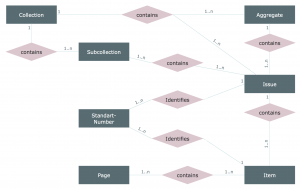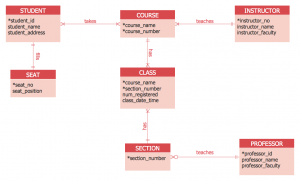

ERD stands for Entity Relationship Diagram, and is typically used for database design to visualize the relationship between entities (people, things, concepts, etc.).
The two notations for ERDs are
1. Chen’s
2. Crow’s Foot
Chen’s notation – The Chen ERD is the traditional method of creating ERDs. Unlike Crow’s feet, all the entities are represented by different symbols and connected by the same connection notation. While cardinality notations may vary based on the design, the basic symbols and how they are all connected stay relatively the same.
Crow’s Foot notation – Similarly to Chen’s, Crow’s Foot serves the purpose to also illustrate entities and their relationships. However, the way in which relationships are connected depends to cardinality and which is the parent entity. For example, when connecting a child entity that only has one parent entity, there will be a small circle at the opposite end of the connecting line from the child. Relationships can have cardinalities of one-to-one, one-to-many, or many-to-many. The illustration of the connecting line will tell the viewer how entities are connected and from what angle.
I think this resource does a really great job of listing the different notations of each ERD since there are quite a few symbols to remember, especially for Crow’s Foot. (https://www.conceptdraw.com/How-To-Guide/notation-symbols-for-erd#:~:text=There%20are%20used%202%20types,notations%3A%20Chen%20and%20Crow’s%20Foot. )
Although Crow’s Foot notation has more symbols to memorize and remember, I personally find it more organized than Chen’s notation because there are less entities to look at. If you know the Crow Foot notation key, it is easy to visualize the data as well as quickly find pieces of information.
Hi Sophie, thanks for your response! I agree, Crows Foot is way easier in my opinion. While I don’t find swimlanes cluttered, there’s something about Chen’s notation that feels very cluttered and difficult to read. Crow’s Foot has many symbols, but they make sense if you take the time to learn them. I also prefer having all the information that belongs to an entity in one space.
Hi Sophie,
I like how you posted two pictures that describe a chen’s and crow’s notions. It helped a lot when reading your post. Explaining Chen’s notion as a “traditional method” makes me wonder if people still use this method or if it is something beginners learn first and then start to advance to crow’s notion. I find crow’s notation a bit challenging versus Chen’s notion that everything is straightforward.
Hey Sophie! I think this was a great explanation of defining how Chen’s notation and Crow’s Foot notation are similar and how they differ. Chen’s notation is great for ERD Diagrams and ERD symbols and I agree ERD symbols help simplify interpreting the visual diagram. Crow’s Foot gives a more in-depth breakdown of how the data is related to each other through ERD tables and cardinality in data modeling.